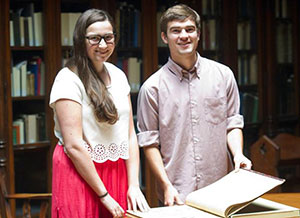“Basically, he was talking trash on his competition,” says John Baranik, C’16, about 19th century Philadelphia music publisher Allyn Bacon. In a letter about a rival’s lower price, Bacon managed to insult two of his competitors in one sentence, saying, “I do not know how his Music looks generally; if it is as bad as Willig’s, he may be glad to get half price.”
As Baranik and Nicole Williams, C’15 are learning, business practices in the early 1800s sound pretty familiar: fierce competition and huge discounts. Williams says, “John was reading Bacon while I was transcribing Benjamin Carr, another Philadelphia publisher, and all of Carr’s letters have invoices. And he’s giving a 60 percent discount, so all of a sudden [the price] goes from $75 to $30. And you think, well, he’s giving you this discount but maybe he should be giving you a better one.”
As founders of the Penn Manuscript Collective, Williams and Baranik are spending the summer in Penn’s Rare Book and Manuscript Library transcribing and creating a database for the correspondence of John Rowe Parker, proprietor of Franklin Music Warehouse in Boston, the largest music distributor in the United States between 1817 and 1821. The project, “Music Printing and Publishing Culture in Early Philadelphia,” is the first initiative of the Collective, designed to coincide with Penn’s upcoming Year of Sound.
Supported by funding from the Center for Undergraduate Research and Fellowships (CURF), the two are examining the content, context, culture, and technology of music publishing in this period, posting work online in order to make the materials more accessible to the Penn community and researchers at large. They’re getting insight on business, culture, daily life, and the headaches of shipping by real ships.
Baranik and Williams ultimately want users to be able to have the same experience they did when reading related letters at the same time. “We want to make [our site] as navigable as possible,” says Baranik. “The publishers are talking about one another, talking about ships, talking about pieces of music. We want to try to have these linked to one another within the site so you can jump from one letter to the next.” The two are blogging about their work, using it as a model of sorts, with plenty of hyperlinks.
That indexing process will take the most time, but can be done from anywhere, unlike the actual transcribing of letters, which can take place only in the library. That’s okay with them, though. “The sixth floor is a magical place,” says Williams of the Rare Book and Manuscript Library.
“I mean, we basically live there now,” adds Baranik.
They’re also planning to expand the Penn Manuscript Collective. They were both drawn to working with manuscripts through classes with Peter Stallybrass, Walter H. and Leonore C. Annenberg Professor in the Humanities and Professor of English and of Comparative Literature and Literary Theory, and they’re counting on others to be similarly inspired. “Having a collaborative group of undergrads working together is the goal for the Manuscript Collective,” says Baranik. “In a perfect world we would have a large team working together on a number of projects, so people could choose their interest.”
Baranik and his roommate, Ben Notkin, C’14, a photographer, have already created a database of Benjamin Franklin’s handwriting. “Ben was Photoshopping it and putting it into tables and doing these image comparisons,” he says. “So it’s great to have people with different skills.”
“For people who are interested in science, we have an entire collection on chemistry,” adds Willliams. “There’s so much to bring in so many different types of people.”
Check out the Penn Manuscript Collective blog here.



